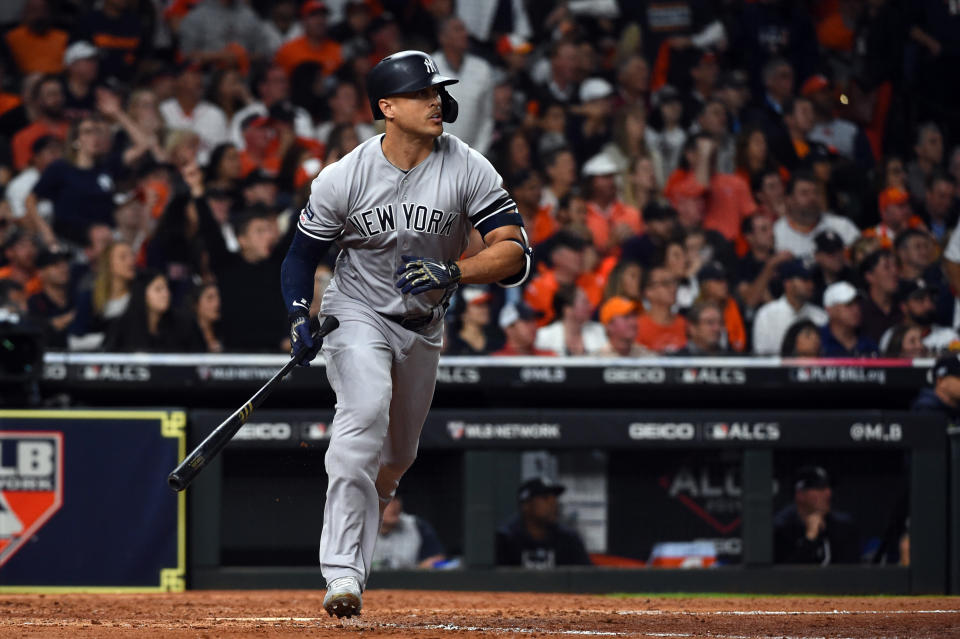Which players should keep hitting home runs (and which will disappoint) in 2020 fantasy baseball?
With this unexpected layoff from sports, we have time to look into some topics that normally fall by the wayside. As a fantasy baseball writer, I have decided to delve into the repeatability of certain standard categories.
Fantasy managers are often torn between chasing power or speed from their early round hitters. After all, the early rounds are where we typically find the hitters who produced elite totals in homers or steals during the previous campaign. I have decided (in a two-part series) to compare the repeatability of elite home run and stolen base totals from recent seasons.
In Part One, we will focus on homers.
[Prep for MLB's return: Create or join a Yahoo Fantasy Baseball League]
We are coming off the most powerful season in MLB history, one that included a shocking 28 players who swatted at least 35 dingers. I decided to set 35 homers as my baseline and used a 10-year sample of 2009-18 as my test group (I couldn’t use 2019, as they do not have a follow-up year to measure).
The test group included 63 players and a total of 110 seasons with at least 35 homers. I wanted to know the degree to which players can be expected to improve or decline after having an elite power season. For those who would like to see the full data, it can be found HERE.
The results were slightly surprising. The average player dipped by 10.5 homers the following year, while the median was a dip of 10 homers.
Here are some fun facts regarding this large group:
· There were five occasions where a player experienced a year-over-year dip of 30 homers or more: Curtis Granderson (2012), Giancarlo Stanton (2018), Chris Carter (2016), Ryan Braun (2012) and Jason Bay (2009). Granderson (36-homer decline) had the single biggest year-over-year drop.
· There were 16 occasions where a player hit at least 35 homers and raised his total the following year. That represents 14.5 percent of the sample size. Christian Yelich had the biggest improvement (eight homers) when he went from 36 round-trippers in 2018 to 44 last season. Mike Trout had the second-biggest year-over-year jump among the 110 samples, with his coming over the identical two-year stretch.
· I could not include the final season of David Ortiz (38 homers), as he did not have a follow-up campaign to measure. Additionally, (for reasons that will become clear later in this article) I did not include three occasions when players went deep at least 35 times after not appearing in an MLB game the previous year.
· Two players appeared on the list five times (Nelson Cruz, Edwin Encarnacion) and five others popped up on four occasions (Nolan Arenado, Giancarlo Stanton, Jose Bautista, Miguel Cabrera, Albert Pujols). Cruz and Arenado were the most consistent sluggers on the list, having never experienced a drop of more than five homers after a campaign of at least 35 long balls. And it was easy to see why Stanton causes managers to pull their hair out, as he experienced an average drop of 20 long balls after each of his appearances on the list.

Conclusions
Should readers simply project all power studs to experience a 10-homer drop the following season?
Of course not. Each player still needs to be analyzed on a case-by-case basis.
The biggest finding came when I added a column for the player’s homer total in the season prior to the one in which he hit at least 35 homers. Players who made a jump of at least 15 homers during the season I measured fell back an average of 13 long balls in the following campaign. Meanwhile, players who produced a homer total within four of their previous year’s mark (whether higher or lower) experienced an average drop of just eight home runs.
[Yahoo Rankings: Overall | C | 1B | 2B | SS | 3B | OF | SP | RP]
To summarize the previous paragraph, players who produced high homer totals for at least two consecutive seasons were more likely to have a high homer total in the following campaign. This finding shouldn’t blow anyone’s mind, but it serves as a major reminder that we need to be careful when expecting those who made major power jumps to maintain their recent surge.
How should we use this data in 2020?
Overall, we likely need to be more skeptical of those who made massive power jumps last season.
Here is a list of those who should be especially scrutinized, with their year-over-year home jump in brackets: Jorge Soler [39], Josh Bell [23], Josh Donaldson [29], Cody Bellinger [22], Max Kepler [16], George Springer [17] and Eugenio Suarez [15].
Managers who seek an elite power bat in the early rounds should target those who have consistently produced high power totals in recent years. And a better plan (which will become more clear in the follow-up article on elite base stealers) is to target players in the early rounds who log solid totals in both long balls and swipes.



